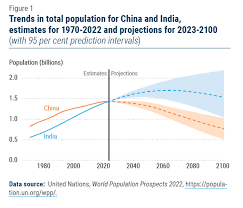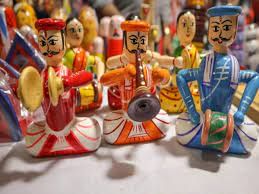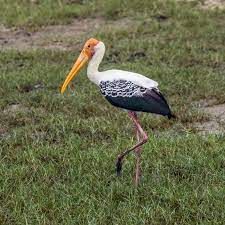UPSC Daily Current Affairs- 4th May 2023 | Current Affairs & Hindu Analysis: Daily, Weekly & Monthly PDF Download
GS-I
Economics of India’s Population Growth
Why in News?
The annual State of World Population report 2023 by the UN Population Fund (UNFPA) stated that India’s population is expected to surpass that of China by the middle of this year at the latest.
Population vs Economic development
- Starting point of this debate is Thomas Malthus’ argument in 1798.
- Malthusianism is the theory that population growth is potentially exponential while the growth of the food supply or other resources is linear, which eventually reduces living standards to the point of triggering a population decline. This event, called a Malthusian catastrophe.
- Since then, however, the world population has grown eight times to reach 8 billion.
- During the 1950s and 60s, “the general view of economists was that high birth rates and rapid population growth in poor countries would divert scarce capital away from savings and investment, thereby placing a drag on economic development.
- However, between the 1970s and 1990s, several studies “failed to detect a robust relationship between national population growth rates and per capita income growth”
- The global view reverted in the 1990s when researchers again found a clear “negative association between population growth and economic performance”.
- During this time, World was also introduced to the concept of “demographic dividend” i.e., high economic growth when there is a bulge in the working-age population (roughly speaking, population between 15 and 65 years).
In Indian Context
- Opportunities for India:
- Theory of demographic transition suggests that population growth is linked to overall levels of economic development as more people are able to produce more goods.
- The rising young population (>66 % population in 15-59 age) provides India with a great opportunity for growth, peppered with the possibility of path-breaking innovation.
- India’s population heterogeneity ensures that this window of demographic dividend becomes available at different times in different States.
- Farming and industry will be able to benefit from economies of scale.
- It will lead to higher tax revenues which can be spent on public goods, such as health care and environmental projects.
- The size of the population is intimately connected to the global power dynamics shaping the relationship between nations and regions.
- Issues with population:
- The increase in the working-age population may lead to rising unemployment, fueling economic and social risks.
- High population growth also affects the faster depletion of resources.
- The 65+ category is going to grow quite fast i.e., increase from 8.6% now to 13% by 2030.
- If India is unable to reap demographic dividend, it will become a demographic disaster.
Lessons for India
- India’s fertility rate (the number of children per woman) is already below the replacement rate of 2.1 but the population will peak by 2064.
- The bigger challenge now is to figure out how to best use India’s demographic dividend because despite China growing at remarkably high over the past four decades it may become old before becoming rich.
- Countries like Singapore, Taiwan and South Korea have already shown us how demographic dividend can be reaped to achieve incredible economic growth by:
- Increasing women’s participation in the workforce. As of 2022,29.4 % of women were working or looking for work, down from 34.1% in 2003-04.
- Investing more in children and adolescents, particularly in nutrition and learning during early childhood.
- A greater focus needs to be on transitioning from secondary education to universal skilling and entrepreneurship, as done in South Korea.
- Health investments - Evidence suggests that better health facilitates improved economic production.
- Making reproductive healthcare services accessible on a rights-based approach. We need to provide universal access to high-quality primary healthcare.
- India needs to address the diversity between States. Southern States, which are advanced in demographic transition, already have a higher percentage of older people.
- A new federal approach to governance reforms for demographic dividend will need to be put in place for policy coordination between States on various emerging population issues such as migration, ageing, skilling, female workforce participation and urbanization.
Conclusion
- India has a window of opportunity to reap the benefits of demographic dividend until 2040s otherwise it could become demographic liability or demographic disaster.
Source: The Hindu
What are Channapatna Toys?
Why in News?
Toy manufacturers in Channapatna, Karnataka, applauded the Government's decision to prohibit the import of toys from China and said that the government's action is contributing to augmenting their profitability.
About Channapatna Toys:
- Channapatna toys are a particular form of wooden toys and dolls that are manufactured in the town of Channapatna in the Ramanagara district of Karnataka.
- Channapatna is also known as Gombegala Ooru (toy-town).
- History:
- The historic ruler of Mysore, Tipu Sultan, is the one attributed to introducing these wooden toys to the current town of Channapatna.
- He invited artists from Persia to train the local artists in wooden toy making, which then helped this industry thrive locally.
- Features:
- Most of these toys are handmade.
- They are also painted in organic colours extracted from vegetables and plants and natural dyes, making the Channapatna Toys 100% chemical free.
- Traditionally, they are mostly made of Ivory Wood. However, nowadays, sandalwood and mango wood are also used.
- Their shapes are mostly round and cubes with blunt edges, so they are completely safe for kids.
- They received the geographical indication (GI) tag in 2005.
Source: The Print
GS-II
National SC-ST Hub Scheme
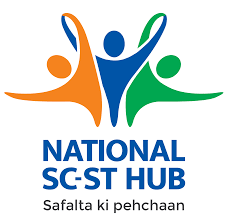
Why in News?
Recently, the Prime Minister praises National SC-ST Hub Scheme for crossing over 1 lakh beneficiary registrations.
About National SC-ST Hub Scheme:-
- The National SC-ST Hub (NSSH) is under the Ministry of Micro, Small and Medium Enterprises.
- It has been set up to provide professional support to Scheduled Caste and Scheduled Tribe Entrepreneurs to fulfil the obligations under the Central Government Public Procurement Policy for Micro and Small Enterprises Order 2012, adopt applicable business practices and leverage the Stand-Up India initiative.
- The key action areas of NSSH include vendor development, participation in public procurement, building a reliable database, mentoring and handholding support, policy advocacy with states, credit facilitation, capacity building, private affirmative action, technology upgradation, marketing support, and special subsidies under various schemes.
- The NSSH works on the mentioned priority areas through various sub-schemes which are as follows:
- Special Credit Linked Capital Subsidy Scheme
- Special Marketing Assistance Scheme
- Single Point Registration Scheme
- Bank Loan Processing Reimbursement Scheme
- Bank Guarantee Charges Reimbursement Scheme
- Testing Fee Reimbursement Scheme
- Export Promotion Council Membership Reimbursement Scheme
- Top 50 NIRF Rated Management Institution’s Short-Term Training Program Fee Reimbursement Scheme
Key Benefits of the Scheme:-
- To achieve the 4% Public Procurement target from SC-ST entrepreneurs
- Facilitating SC/ST Entrepreneurs to be part of vendor development programs and mentoring support.
- Collection, collation and dissemination of information regarding SC/ST enterprises and entrepreneurs
- Distribution of trade-specific tool kits to trained candidates
Eligibility:-
- Existing and Aspiring SC/ST Entrepreneurs
SOURCE: NEWSONAIR
India hands over two naval vessels for Maldives
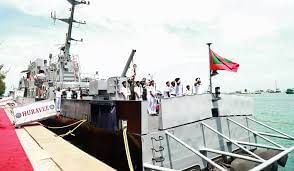
Why in News?
Continuing India’s capacity-building assistance in the Indian Ocean Region (IOR), the Defence Minister recently handed over a Fast Patrol Vessel (FPV) and a Landing Craft Assault ship to the Maldives National Defence Forces (MNDF).
- The FPV, capable of coastal and offshore surveillance at high speeds, was commissioned as MNDF Coast Guard ship Huravee.
About
- Challenges & cooperation:
- The Defence Minister called for collaborative efforts to deal with common challenges faced by IOR, including climate change and sustainable exploitation of maritime resources.
- He also called for enhanced cooperation among nations in the IOR to address the common challenges faced by the region and identified sustainable exploitation of resources and climate change as the most important common challenges faced by the region.
- Significance:
- In recent years, India has significantly scaled up assistance towards capacity building and capability enhancement for Indian Ocean littoral states and countries in the IOR.
- The handing of the two platforms as a symbol of the shared commitment of India and the Maldives towards peace and security in the IOR.
Significance of Indian Ocean region
- Trade & commerce:
- The Indian Ocean region enjoys a privileged location at the crossroads of global trade, connecting the major engines of the international economy in the Northern Atlantic and Asia-Pacific.
- Natural resources:
- Indian Ocean is rich in natural resources.
- Fishing:
- Forty per cent of the world’s offshore oil production takes place in the Indian Ocean basin. Fishing in the Indian Ocean now accounts for almost 15 per cent of the world’s total.
- Mineral resources:
- Mineral resources are equally important, with nodules containing nickel, cobalt, and iron, and massive sulphide deposits of manganese, copper, iron, zinc, silver, and gold present in sizeable quantities on the sea bed. I
- ndian Ocean coastal sediments are also important sources of titanium, zirconium, tin, zinc, and copper.
- Additionally, various rare earth elements are present, even if their extraction is not always commercially feasible.
- Strategic importance for India:
- The Indian Ocean holds particular importance for India, as the littoral’s most populous country.
- Indeed, for the rest of the Ocean’s littoral states, and even those outside the region, India’s leadership role will be important in determining the strategic future.
India – Maldives Relations
- Historical:
- India and Maldives share ethnic, linguistic, cultural, religious and commercial links.
- India was among the first to recognize the Maldives after its independence in 1965 and later established its mission at Male in 1972.
- They officially and amicably decided their maritime boundary in 1976.
- Political Relations:
- Both nations are founding members of the South Asian Association for Regional Cooperation (SAARC), the South Asian Economic Union and signatories to the South Asia Free Trade Agreement.
- They have consistently supported each other in multilateral areas such as the UN, the Commonwealth, the NAM, and the SAARC.
- The Memorandums of Understanding (Mou) signed between both the countries covers areas such as hydrography, health, passenger and cargo services by sea, capacity building in customs and civil service training.
- Strategic Importance:
- The Maldives holds strategic importance for India under the government’s ‘Neighbourhood First’ policy due to its location in the Indian Ocean.
- In the Indian Ocean, the Maldives archipelago comprising 1,200 coral islands lies next to key shipping lanes which ensure uninterrupted energy supplies to countries like China, Japan, and India.
- Both nations are working together to counter China’s presence in the Indian Ocean Region(IOR).
- Trade and Economy:
- India and Maldives signed a trade agreement in 1981, which provides for the export of essential commodities.
- Under the bilateral agreement, India provides essential food items like rice, wheat flour, sugar, dal, onion, potato and eggs and construction material such as sand and stone aggregates to the Maldives on favourable terms.
- India and Maldives signed the $800 million Line of Credit Agreement in March 2019, for assisting the Maldives to achieve sustainable social and economic development.
- India has a positive Balance of Trade with the Maldives.
- Development Assistance Programme:
- India has helped the Maldives in many diverse areas to bolster the development of the Maldives e.g.
- Indira Gandhi Memorial Hospital, Maldives Institute of Technical Education (now called the Maldives Polytechnic),
- India-Maldives Faculty of Hospitality & Tourism Studies,
- Technology Adoption Programme in Education Sector in the Maldives,
- A port on Gulhifalhu, airport redevelopment at Hanimaadhoo, and a hospital and a cricket stadium in Hulhumale etc.
- India has helped the Maldives in many diverse areas to bolster the development of the Maldives e.g.
- India’s crucial help to the Maldives:
- Operation Cactus:
- It was an attempt by a group of Maldivians led by Abdullah Luthufi and assisted by armed mercenaries of a Tamil secessionist organisation from Sri Lanka, the People’s Liberation Organisation of Tamil Eelam (PLOTE), to overthrow the government in the island republic of Maldives on 3rd November 1988.
- The coup failed due to the intervention of the Indian Army, whose military operations efforts were code-named Operation Cactus.
- The Maldives urged India for help following the collapse of the island’s only water treatment plant, India helped by sending its heavy-lift transporters like C-17 Globemaster III, II-76 carrying bottled water.
- Operation Neer:
- It was initiated by the Indian government to help the Maldives after a major fire broke out at the Male Water and Sewerage Company.
- Operation Cactus:
- Diaspora:
- There are 25,000 Indian nationals living in the Maldives (the second largest expatriate community).
- The proximity of location and improvements in air connectivity in recent years has led to a very substantial increase in the number of Indians visiting the Maldives for tourism and business.
- India is a preferred destination for Maldivians for education, medical treatment, recreation, and business.
- Defence:
- A technical agreement on sharing ‘White Shipping Information between the Indian Navy and the Maldives National Defence Force was also signed, enabling the exchange of prior information on the movement of commercial, non-military vessels.
- India has adopted a very flexible and accommodating approach in meeting Maldivian requirements of defence training and equipment.
- Ekuverin is a joint military exercise between India and Maldives.
- Pivot role in the SAGAR Initiative of India:
- The Maldives is key to India’s ambition to become a regional maritime security provider.
- Anti-Piracy and Anti-Terror operations can also be carried out with Maldives' help.
Source: The Hindu
Protection of Children from Sexual Offences Act (POCSO Act)
Why in News?
The Bombay High Court recently said that the POCSO Act was enacted not to punish minors in a consensual relationship and to brand them as criminals.
About Protection of Children from Sexual Offences Act (POCSO Act):
- It is the first comprehensive law in India dealing specifically with the sexual abuse of children, enacted in 2012.
- It is administered by the Ministry of Women and Child Development (MoWCD).
- Objective: The Act was designed to protect children aged less than 18 from sexual assault, sexual harassment and pornography offences and provide for the establishment of Special Courts for the trial of such offences and related matters and incidents.
- Salient Features:
- Gender-neutral law: The POCSO Act establishes a gender-neutral tone for the legal framework available to child sexual abuse victims by defining a child as “any person” under the age of 18.
- It defines various types of sexual abuse, such as penetrative and non-penetrative assault, as well as sexual harassment and pornography.
- It considers a sexual assault to be aggravated in certain circumstances, such as when the abused child is mentally ill or when the abuse is committed by someone in a position of trust or authority over the child, such as a family member, etc.
- People who traffic children for sexual purposes are also punishable under the provisions relating to abetment in the Act.
- The attempt to commit an offence under the Act has been made liable for punishment for upto half the punishment prescribed for the commission of the offence.
- No time limit for reporting abuse: A victim can report an offence at any time, even a number of years after the abuse has been committed.
- Mandatory reporting: The Act also makes it the legal duty of a person aware of the offence to report sexual abuse. In case s/he fails to do so, the person can be punished with six months imprisonment or a fine.
- Safeguards to victims: The Act incorporates child-friendly procedures for reporting, recording of evidence, investigation and trial of offences. These include:
- Recording the statement of the child at the residence of the child or at the place of his choice, preferably by a woman police officer not below the rank of sub-inspector.
- No child is to be detained in the police station at night for any reason.
- Police officers to not be in uniform while recording the statement of the child.
- The statement of the child is to be recorded as spoken by the child.
- Medical examination of the child is to be conducted in the presence of the parent of the child or any other person in whom the child has trust or confidence.
- No aggressive questioning or character assassination of the child in-camera trial of cases.
- The Act specifically laid down that the child victim should not see the accused at the time of testifying and that the trial be held in camera.
- It also required that the Special Court complete the trial, as far as possible, within a period of one year from the date of cognisance.
Amendment to the Act:
- The Act was amended for the first time in 2019to enhance the punishments for specific offences in order to deter abusers and ensure a dignified childhood.
- This amendment enhanced the punishment to include the death penalty for aggravated penetrative sexual assault of the child.
- It also provides for levy of fines and imprisonment of up to 20 years to curb child pornography.
Source: The Print
GS-III
De-dollarisation
Why in News?
There's a growing trend of countries sidestepping the US dollar (de-dollarisation) and choosing to use their own local currencies for bilateral trade.
What is de-dollarisation?
- De-dollarisation is a term that refers to the process whereby countries tend to reduce their reliance on the US dollar as a reserve currency, medium of exchange, and also a unit of account.
Why is the US dollar used so widely?
- Dominance of Dollar: After World War II, the US dollar replaced the British pound as the dominating currency worldwide. In 1944, the Bretton Woods Agreement established the dollar as the world’s reserve currency. The original Bretton Woods Agreement is dead, but the dollar remains the international reserve currency.
- Trade deficit of US: U.S. has been running a persistent trade deficit for decades now (in fact the last time the U.S. ran a trade surplus was way back in 1975). The excess dollars that the rest of the world accumulates due to the U.S. 's trade deficit has been invested in U.S. assets such as in debt securities issued by the US government.
- Popularity of U.S. assets among investors: The high level of trust that global investors have in the U.S. financial markets, perhaps owing to the ‘rule of law’ in the U.S., is considered to be a major reason why investors prefer to invest in U.S. assets.
What is Reserve Currency?
- Reserve currencies are foreign currencies held by central banks and other monetary authorities to facilitate international transactions, stabilize exchange rates, and bolster financial confidence.
- These currencies are typically characterized by their stability, liquidity, and wide acceptance in global markets, which make them attractive for holding and conducting international transactions.
- A reserve currency is also used by central banks to prepare for international debt obligations and to influence their domestic exchange rate.
Global Efforts Towards Dedollarization
- In recent years, several countries and regions have embarked on the path towards dedollarization, driven by a combination of geopolitical, economic, and strategic considerations.
- Notable examples include China, Russia, Brazil and the European Union, each of which has taken steps to reduce their reliance on the US dollar in international transactions and financial markets.
Why are de-dollarisation attempts being made?
- Sanctions by U.S.: The U.S. imposed several sanctions that restricted the use of the U.S. dollar to purchase oil and other goods from Russia, and this has been seen by many countries as an attempt to weaponise the dollar.
- Power to control transactions by U.S.: Since international transactions carried out in the U.S. dollar are cleared by American banks, this gives the U.S. government significant power to oversee and control these transactions.
- To end U.S Hegemony: Some countries, like China and Russia, have sought to diminish the influence of the US dollar as a means of countering perceived American hegemony and mitigating the impact of US sanctions.
- To Promote their own currency: Other countries, particularly those in the Eurozone, have pursued dedollarisation to promote the international use of their currency, the euro, in a bid to enhance their global economic standing and secure greater financial autonomy.
Challenges Towards Dedollarisation
- Threat to Global Financial Stability: As countries reduce their reliance on the US dollar, adjustments in the composition of global reserve assets may lead to shifts in capital flows and changes in asset prices. In the absence of adequate policy coordination and risk management, these fluctuations could create financial instability.
- Alternative currency: Creating a viable alternative to the US dollar presents a formidable challenge. To achieve the requisite degree of stability, liquidity, and acceptability, an alternative reserve currency must be underpinned by a robust economy, deep and liquid financial markets, and sound monetary and fiscal policy frameworks. Currently, no single currency fully meets these criteria, although the euro and the Chinese yuan have made strides in this regard.
- Increased volatility in Exchange rates: Dedollarisation could result in increased volatility in currency exchange rates, particularly during the initial phases of transition. This, in turn, could impact trade, investment, and capital flows, particularly for countries with less developed financial markets or limited policy tools to manage exchange rate volatility.
Should India Focus on De-dollarisation?
- Benefits: It could reduce the vulnerability to fluctuations in US monetary policy and enhance monetary autonomy, enabling them to better tailor policy actions to the domestic economic conditions.
- Moreover, the diversification of reserve currencies could provide a buffer against currency fluctuations and capital flow reversals, reducing the likelihood of financial crises and improving overall financial stability.
- Challenges: As developing countries transition away from the US dollar, they may face heightened exchange rate volatility, which could impact trade, investment, and capital flows.
- Additionally, the development of deep and liquid domestic financial markets – a prerequisite for currency internationalisation – could prove to be a formidable challenge for countries with less developed financial systems.
- Furthermore, the potential costs associated with the transition, such as adjustments to existing trade and financial arrangements, may be significant and could strain limited resources.
Way Ahead
- In light of these considerations, developing countries like India should adopt a prudent and measured approach towards dedollarisation. Policymakers must strike a delicate balance between the potential benefits of reducing reliance on the US dollar and the risks and costs associated with such a transition.
- While dedollarisation presents opportunities for a more diversified and resilient global financial system, it also poses significant challenges that must be carefully managed to ensure the preservation of global financial stability and sustained economic growth.
- Developing countries such as India must carefully weigh the potential benefits and risks associated with this transition.
Source: The Hindu
Painted storks
Why in News?
Recently, close to 4,000 painted storks were found nesting in two Andhra Pradesh villages.
About Painted Storks:-
- The painted stork (Mycteria leucocephala ) is a large wader in the stork family.
- It is found in the wetlands of the plains of tropical Asia, south of the Himalayas, in the Indian Subcontinent and extending into Southeast Asia.
- Their distinctive pink tertial feathers of the adults give them their name.
- They forage in flocks in shallow waters along rivers or lakes.
- They are not migratory and only make short-distance movements in some parts of their range in response to changes in weather or food availability or for breeding.
Distribution:-
- Painted storks are widely distributed over the plains of Asia.
- They are found south of the Himalayan ranges and are bounded on the west by the Indus River system where they are rare and extend eastwards into Southeast Asia.
- Painted storks are absent from very dry or desert regions, dense forests, and higher hill regions.
- They prefer freshwater wetlands in all seasons but also use irrigation canals and crop fields, particularly flooded rice fields during the monsoon.
Conservation Status:-
- IUCN Red List: Near Threatened
- Wildlife Protection Act: Schedule-IV
Source: The Hindu
|
38 videos|5293 docs|1118 tests
|
FAQs on UPSC Daily Current Affairs- 4th May 2023 - Current Affairs & Hindu Analysis: Daily, Weekly & Monthly
| 1. What is the GS-I paper in UPSC? |  |
| 2. What are the subjects covered in GS-II paper of UPSC? |  |
| 3. How can I prepare for the UPSC GS-III paper? |  |
| 4. What is the importance of current affairs in UPSC exams? |  |
| 5. How can I stay updated with daily current affairs for UPSC preparation? |  |

